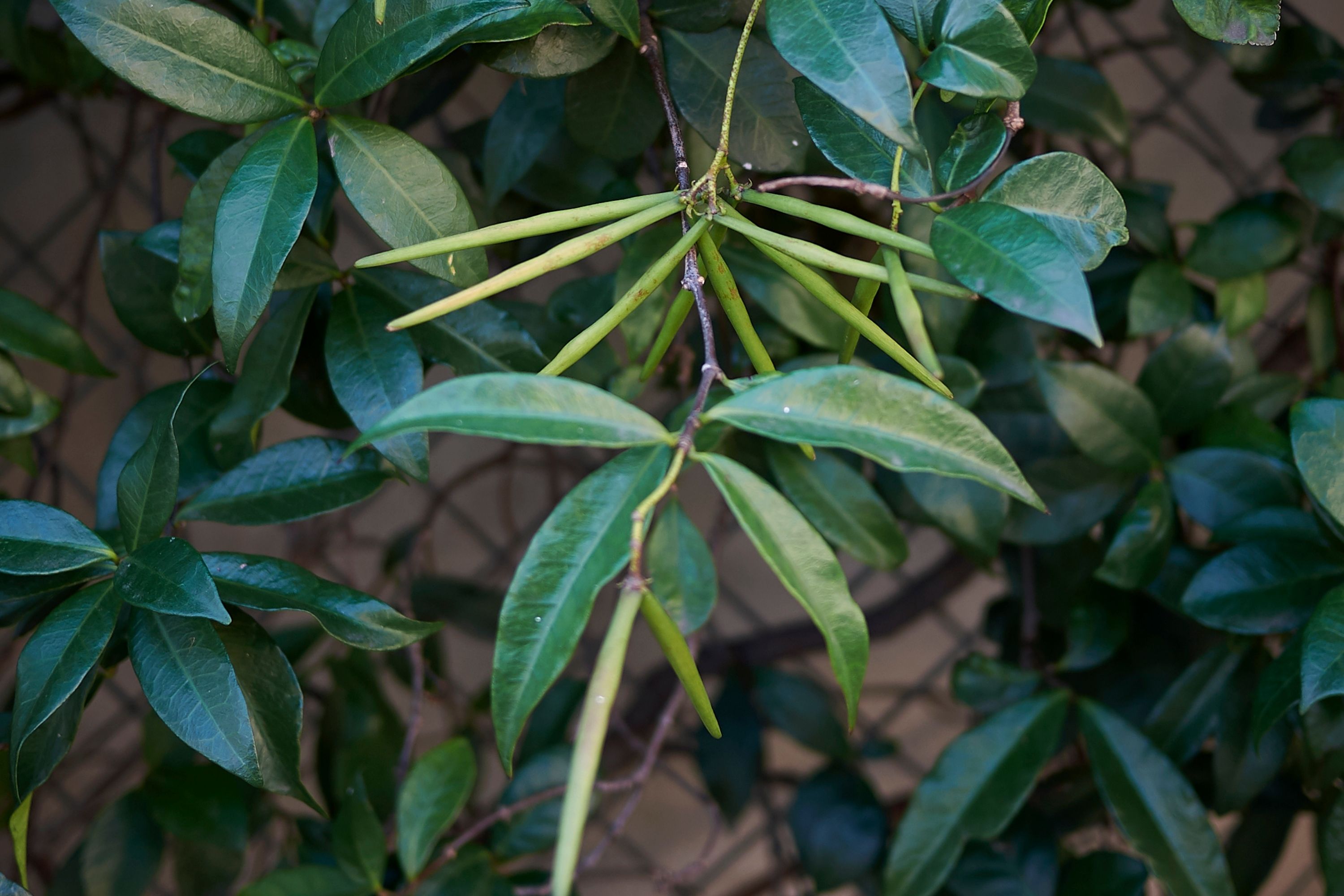Star jasmine
(Trachelospermum jasminoides)

Description
Trachelospermum jasminoides, commonly known as star jasmine or confederate jasmine, is a species of evergreen vine that belongs to the Apocynaceae family. Native to East Asia, specifically China, Japan, and Korea, this fragrant flowering plant has gained immense popularity worldwide for its beauty, versatility, and enticing aroma. In this article, we will delve into the botanical characteristics, cultivation requirements, and practical applications of Trachelospermum jasminoides. Taxonomy and Nomenclature Trachelospermum jasminoides was first described by the renowned German botanist Carl Peter Thunberg in 1794. The genus name "Trachelospermum" is derived from the Greek words "trachelos," meaning "neck," and "sperma," meaning "seed," referring to the elongated seed pods found in some species of this genus. The species epithet "jasminoides" stems from its resemblance to true jasmines, particularly in its fragrant flowers. Botanical Description Trachelospermum jasminoides, commonly known as star jasmine or confederate jasmine, exhibits a distinctive physical appearance characterized by its climbing nature and attractive foliage and flowers. Here are the key features of its physical appearance: Growth Habit: Trachelospermum jasminoides is a woody, evergreen vine that climbs by twining its stems around a support structure. It can reach heights of 15 to 20 feet (4.5 to 6 meters) when provided with suitable support. Leaves: The glossy, dark green leaves of Trachelospermum jasminoides are one of its defining characteristics. They are leathery and arranged opposite each other along the stems. The shape of the leaves is lanceolate or ovate, with pointed tips. Each leaf typically measures about 1 to 2 inches (2.5 to 5 cm) in length. Flowers: The flowers of Trachelospermum jasminoides are particularly striking and contribute to its popular name, star jasmine. The blooms appear in clusters and are small, white, and star-shaped, consisting of five petals that spread outward from a central point. The flowers emit a delightful fragrance reminiscent of true jasmine, adding to their allure. Fragrance: Trachelospermum jasminoides is renowned for its enchanting fragrance, which is often described as sweet, rich, and reminiscent of true jasmine. The intoxicating scent of the flowers permeates the air, making it a sought-after choice for fragrance gardens and outdoor spaces. Overall, Trachelospermum jasminoides showcases a combination of glossy, dark green foliage and clusters of small, white, star-shaped flowers with a captivating fragrance, creating an appealing and visually appealing display. Habitat and Range Trachelospermum jasminoides, commonly known as star jasmine or confederate jasmine, is native to East Asia, specifically China, Japan, and Korea. It thrives in a range of habitats within its native range. Here are some details about its habitat and range: Geographic Range: Trachelospermum jasminoides is native to East Asia and is distributed across a wide area within China, including regions such as Guangdong, Guangxi, and Yunnan provinces. It is also found in various parts of Japan and Korea. Climatic Requirements: This species is well-adapted to temperate and subtropical regions. It prefers regions with mild winters and warm summers. It can tolerate a range of temperatures but may suffer frost damage in colder climates. In its native range, it is commonly found in regions with a humid climate. Habitat: Trachelospermum jasminoides grows in a variety of habitats within its native range. It is often found in forests, woodland edges, thickets, and along hillsides. It thrives in areas with well-drained soil and ample sunlight. Cultivated Range: Due to its ornamental value, Trachelospermum jasminoides has been widely cultivated and naturalized in many other regions around the world. It is commonly grown in gardens, parks, and landscapes in temperate and subtropical regions worldwide. It can be found in various parts of North America, Europe, Australia, and other regions with suitable climates. In summary, Trachelospermum jasminoides is native to East Asia, including China, Japan, and Korea. It prefers temperate and subtropical climates and can be found in a range of habitats, including forests, woodland edges, and hillsides. It has also been cultivated and naturalized in numerous other regions globally, where it is appreciated for its beauty and fragrance. Cultivation Trachelospermum jasminoides thrives in temperate and subtropical regions, but it can also be grown as a container plant in colder climates. Here are some key considerations for successful cultivation: Sunlight: Star jasmine prefers full sun to partial shade. It performs best when exposed to at least six hours of direct sunlight daily. Soil: Well-draining soil enriched with organic matter is ideal for Trachelospermum jasminoides. It can tolerate a range of soil types, including sandy or loamy soils. Watering: While Trachelospermum jasminoides is moderately drought-tolerant, regular watering is necessary, particularly during hot and dry periods. Adequate moisture is crucial during the plant's establishment phase. Pruning: Pruning helps maintain the shape and control the growth of the vine. It is typically carried out in late winter or early spring before new growth begins. Trimming away dead or damaged branches and shaping the vine can promote healthier growth and better aesthetics. Support Structure: Being a climbing vine, Trachelospermum jasminoides requires a support structure such as a trellis, fence, or pergola. Providing a sturdy framework allows the plant to climb and display its cascading foliage and flowers. Practical Applications Trachelospermum jasminoides possesses numerous practical applications due to its aesthetic appeal and fragrance. Here are some common uses: Ornamental Purposes: With its evergreen foliage and profusion of fragrant blooms, Trachelospermum jasminoides is widely cultivated for ornamental purposes in gardens, parks, and landscapes. Its ability to climb and cover walls, fences, and arbors makes it an excellent choice for creating green screens and adding vertical interest to outdoor spaces. Ground Cover: Trachelospermum jasminoides can be used as a ground cover plant in larger areas. Its sprawling growth habit and dense foliage help suppress weed growth and provide an attractive carpet of greenery. Container Planting: Due to its adaptability, Trachelospermum jasminoides can be grown in containers and placed on patios, balconies, or courtyards. This allows gardeners with limited space to enjoy the beauty and fragrance of this vine. Fragrance Gardens: The intense and intoxicating fragrance of Trachelospermum jasminoides flowers makes it a popular choice for fragrance gardens. The sweet scent attracts visitors and adds a sensory delight to outdoor spaces. Indoor Cultivation: In regions with harsh winters or unsuitable climates, Trachelospermum jasminoides can be grown as a houseplant. With proper care, it can thrive indoors, providing a touch of natural beauty and fragrance to homes and indoor spaces. Medicinal and Cultural Significance Beyond its horticultural uses, Trachelospermum jasminoides holds cultural and medicinal significance in some regions. In traditional Chinese medicine, certain parts of the plant, including the leaves and stems, are believed to possess medicinal properties. They are used to treat various ailments, including rheumatism, inflammation, and skin conditions. In Chinese and Japanese cultures, Trachelospermum jasminoides has symbolic value and is often associated with purity, love, and beauty. The flowers are used in traditional floral arrangements, tea ceremonies, and cultural celebrations. Precautions While Trachelospermum jasminoides is generally safe to handle and grow, it's important to note that all parts of the plant are considered mildly toxic if ingested. It is advisable to keep the plant away from children and pets and to seek medical attention if accidental ingestion occurs. Conclusion Trachelospermum jasminoides, also known as star jasmine or confederate jasmine, is an enchanting flowering vine that captivates with its fragrant white blossoms and glossy foliage. With its versatility, adaptability, and aesthetic appeal, it has become a popular choice among gardeners, landscape designers, and nature enthusiasts worldwide. Whether used for vertical accents, ground cover, or fragrance gardens, Trachelospermum jasminoides brings beauty and a touch of elegance to outdoor and indoor spaces. Its cultural significance and medicinal properties further enhance its value, making it a cherished plant with a multitude of practical applications.
Taxonomic tree:







